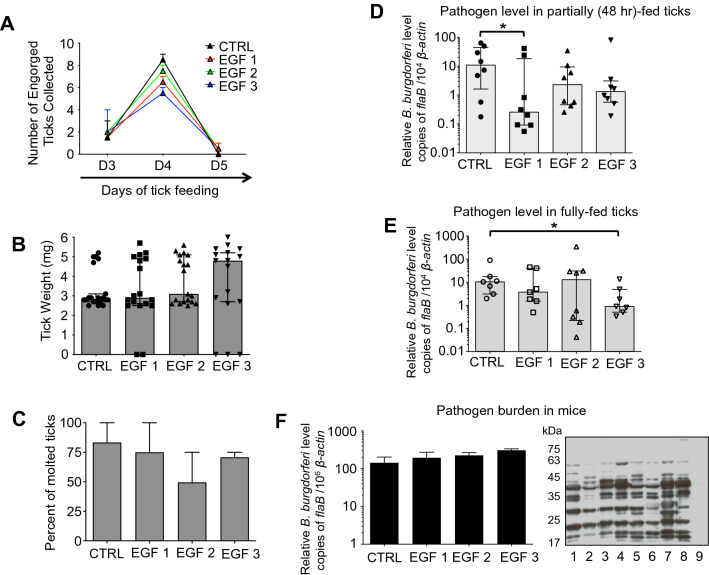Figure 5.
EGF immunization affects B. burgdorferi acquisition. Mice were immunized with Is86 EGF-1, -2, or -3, infected with B. burgdorferi, and then parasitized by naïve ticks. Ticks that fed on mice immunized with adjuvant only were used as controls. (A) Mean number of replete ticks, with error bars showing ± SEM. Fully replete ticks were collected and counted (n = 20, 17, 20, 16 ticks/group of 2 mice, respectively). (B) Median tick engorgement weight. The weights of fully replete ticks (n = 20, 18, 19, 17 ticks/group, respectively) were measured with error bars showing 95% confidence intervals (CI). Data points with zero values indicate unattached live or dead ticks collected 24 h post infestation. (C) Mean tick molting rate, with error bars showing ± SEM. The collected ticks were allowed to molt (n = 6, 7, 8, 7 ticks/group of 2 mice, respectively) in the incubator, and the percentage of molted ticks was calculated. Median B. burgdorferi burdens in (D) 48-h fed ticks and (E) fully replete ticks (n = 8, 7 ticks/group, respectively), with error bars showing 95% CI. Spirochete burdens in ticks were assessed by measuring copies of flaB using qPCR and normalizing against tick β-actin. (F) Mean B. burgdorferi burden in mouse skin (n = 2), with error bars showing ± SEM. This experiment represents the acquisition of spirochetes from infected mice to naïve ticks. Murine skin samples were collected after the completion of tick feeding. Spirochete levels were evaluated by measuring copies of flaB using qPCR and normalizing against mouse β-actin. The right-side panel shows a Western blot of B. burgdorferi lysates, which were probed with B. burgdorferi-infected mouse sera (control groups in lanes 1 and 2, EGF-1-immunized in lanes 3 and 4, EGF-2-immunized in lanes 5 and 6, EGF-3-immunized in lanes 7 and 8, and normal mouse serum in lane 9). The asterisks in the graphs indicate statistically significant differences at p < 0.05.

